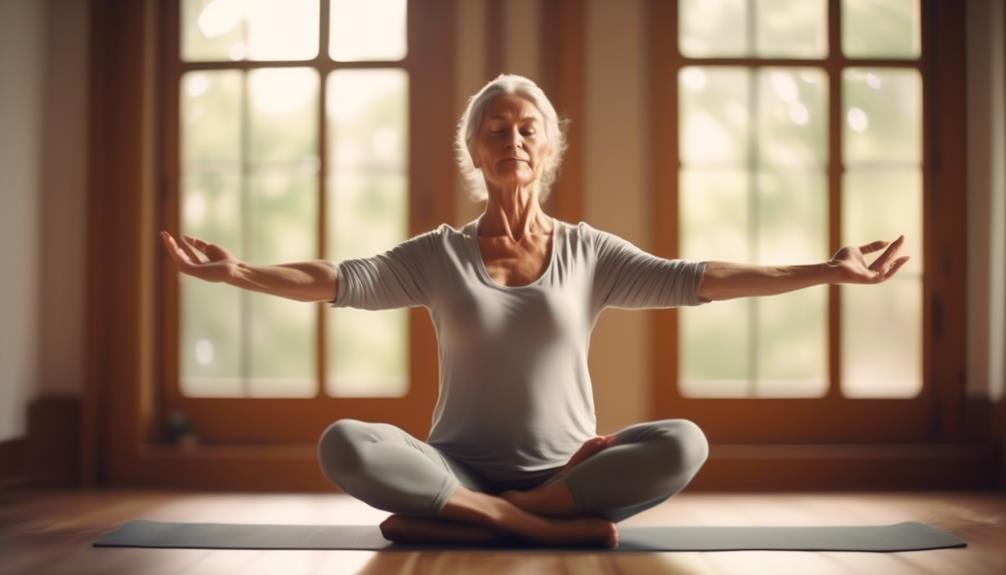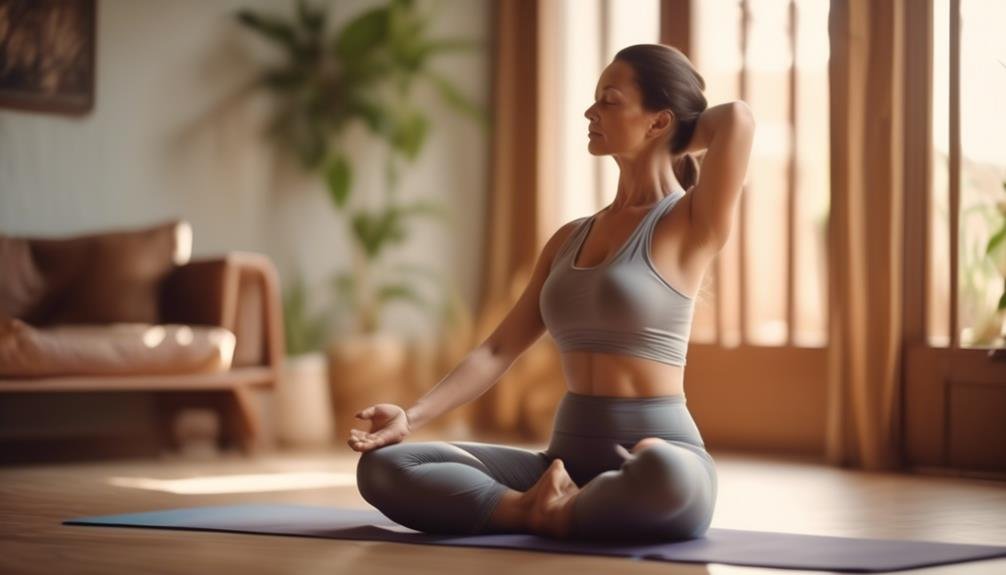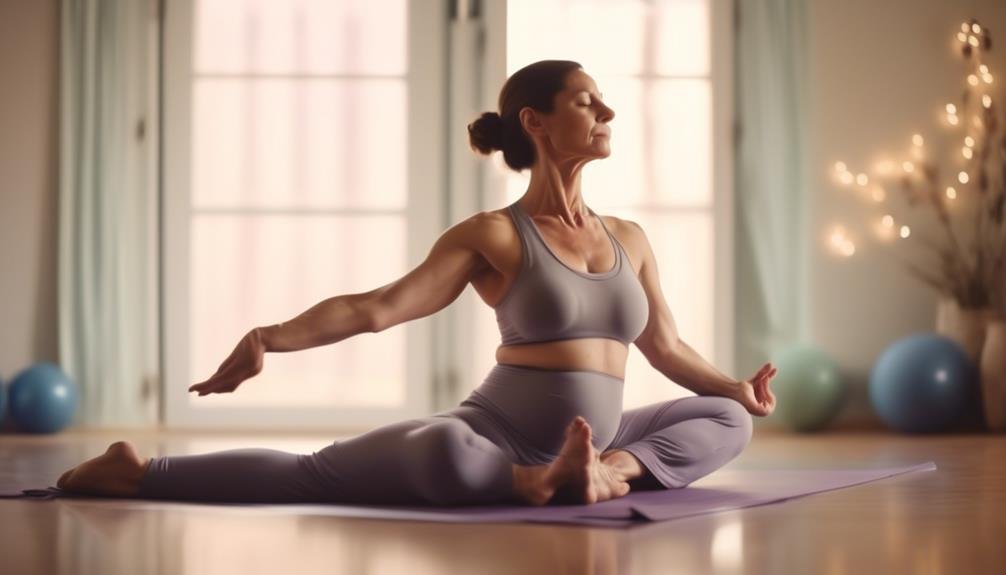"Cherishing Little Steps - A Haven for Baby and Family Journeys"
Yoga Moves for Postnatal Recovery
When it comes to postnatal recovery, you want to regain strength, flexibility, and find a sense of calm amidst the chaos of motherhood. Yoga moves can be a powerful tool to help you achieve these goals. In this discussion, we will explore a range of yoga poses specifically designed to aid in your postnatal recovery journey.
From gentle stretches to pelvic floor exercises, core strengthening to hip openers, there are countless ways to support your body and mind during this transformative period. Whether you're a new mom or have recently given birth, these yoga moves will provide you with the tools you need to nourish and restore yourself.
So, let's dive into the world of postnatal yoga and discover the healing potential it holds for you.
Key Takeaways
- Gentle stretches and releases can help alleviate postpartum aches and pains and improve flexibility.
- Pelvic floor exercises, such as Kegels, are important for maintaining bladder and bowel control and preventing pelvic floor issues.
- Core strengthening exercises, like pelvic tilts and plank pose, are essential for postnatal recovery and physical well-being.
- Hip openers in yoga can relieve discomfort and improve flexibility in the hips, which may be tight and stiff after pregnancy.
Gentle Stretches

To aid in your postnatal recovery, incorporating gentle stretches into your daily routine can help relieve tension and promote relaxation. After childbirth, your body goes through a lot of changes, both physically and emotionally. Gentle stretching can be beneficial in several ways.
First, it helps to release tight muscles and improve flexibility, which can be particularly helpful if you experienced any discomfort during pregnancy or labor.
Secondly, gentle stretches can help to improve circulation, which aids in healing and reduces the risk of blood clots. Additionally, stretching can help to alleviate postpartum aches and pains, such as lower back pain and tight shoulders.
When incorporating stretches into your postnatal routine, it's important to choose pregnancy-safe yoga poses. These poses are specifically designed to support your body during this delicate phase. Some examples include cat-cow stretch, child's pose, and gentle twists.
These poses not only target the areas that are commonly affected by pregnancy and childbirth, but they also provide a sense of calm and relaxation.
Pelvic Floor Exercises
If you're looking to further strengthen your postnatal recovery, focusing on pelvic floor exercises is essential. The pelvic floor muscles play a crucial role in supporting your pelvic organs and maintaining bladder and bowel control. After giving birth, these muscles can become weakened or stretched, leading to pelvic floor dysfunction. But don't worry, there are simple and effective exercises you can do to help restore strength and function to your pelvic floor.
One of the most well-known exercises for the pelvic floor is Kegel exercises. These exercises involve contracting and relaxing the muscles that control urination. By regularly practicing Kegels, you can improve muscle tone and prevent or manage pelvic floor issues.
To help you get started, here's a simple table outlining three different Kegel exercises you can try:
| Exercise | How to Do It |
|---|---|
| Quick flicks | Quickly squeeze and release your pelvic floor muscles, as if you're stopping the flow of urine. Repeat 10 times. |
| Slow contractions | Gradually tighten your pelvic floor muscles as much as you can, hold for 5 seconds, then release. Repeat 5 times. |
| Elevator lifts | Imagine your pelvic floor muscles are an elevator. Slowly lift them from the ground floor to the top floor, then lower them back down. Repeat 5 times. |
Core Strengthening

Strengthening your core muscles is crucial for postnatal recovery and overall physical well-being. After pregnancy, your abdominal muscles may have weakened and stretched, leaving you with a weak core. But fear not, as there are simple and effective recovery exercises that can help you regain your core strength and tone your abdomen.
Here are three essential core-strengthening exercises that will support your postnatal recovery:
- Pelvic tilts: Lie on your back with your knees bent and feet flat on the floor. Slowly tilt your pelvis towards your belly button, engaging your abdominal muscles. Hold for a few seconds before releasing. Repeat 10 times.
- Plank pose: Start on all fours, then extend your legs back, balancing on your toes and forearms. Keep your body in a straight line from head to heels, engaging your core muscles. Hold for 30 seconds to 1 minute, gradually increasing the duration as you get stronger.
- Leg raises: Lie on your back with your legs extended. Slowly lift one leg towards the ceiling while keeping your core engaged. Lower it back down and repeat with the other leg. Aim for 10-15 repetitions on each side.
Hip Openers

Now that you have strengthened your core muscles, it's time to focus on hip openers to further support your postnatal recovery and enhance your overall physical well-being. Pregnancy discomfort and the physical changes your body went through during pregnancy can often lead to tightness and stiffness in the hips. Hip openers in yoga can help relieve this discomfort and improve your flexibility, allowing you to move more freely and comfortably.
Here are some beneficial hip-opening yoga poses that you can incorporate into your postnatal routine:
| Pose | Benefits |
|---|---|
| Pigeon pose | Relieves tension in the hips and lower back, improves hip flexibility |
| Goddess pose | Strengthens the hips, opens the groin, and improves overall body balance |
| Butterfly pose | Stretches the inner thighs and groin, promotes relaxation and calmness |
| Low lunge | Opens up the hip flexors, stretches the thighs, and improves posture |
| Bound angle pose | Relieves fatigue, stimulates the reproductive organs, and reduces stress |
Remember to listen to your body and only go as far as feels comfortable. Take deep breaths and allow yourself to relax into each pose. By incorporating these hip openers into your postnatal routine, you can alleviate pregnancy discomfort and improve your flexibility, promoting a greater sense of well-being.
Shoulder and Upper Back Release

To find relief and restore mobility to your shoulders and upper back after pregnancy, incorporate these yoga poses into your postnatal routine:
- Child's Pose (Balasana): Begin on your hands and knees, then sit back on your heels with your arms stretched out in front of you. This gentle stretch will release tension in your upper back while allowing your shoulders to relax.
- Cat-Cow Pose (Marjaryasana-Bitilasana): Start on your hands and knees, and then alternate between arching your back like a cat and dropping your belly towards the ground like a cow. This movement will help to increase shoulder mobility and relieve any tightness in your upper back.
- Thread the Needle Pose (Parsva Balasana): Begin on your hands and knees, then reach your right arm underneath your left arm and rest your right shoulder and ear on the mat. This pose will release tension in your shoulders and upper back, providing much-needed relief.
Relaxation and Meditation

After relieving tension in your shoulders and upper back, it's time to focus on finding relaxation and peace through meditation. As a new mother, you may be experiencing high levels of stress and anxiety. Incorporating mindfulness practices into your postnatal recovery can help you find relief from these overwhelming emotions.
Meditation is a powerful tool for stress relief. By taking a few moments each day to sit in stillness and quiet your mind, you can cultivate a sense of calm and inner peace. Find a comfortable position, close your eyes, and take deep, slow breaths. Allow your thoughts to come and go without judgment, simply observing them as they arise and then gently letting them go.
Mindfulness practices, such as meditation, can help you become more present and aware of your thoughts, feelings, and sensations. This heightened awareness can bring about a greater sense of clarity and help you navigate the challenges of motherhood with more ease. By regularly engaging in these practices, you can develop a greater sense of self-compassion and learn to respond to stress in a healthier way.
Balancing Poses

Finding balance in your postnatal recovery is crucial, and one way to achieve it's through the practice of balancing poses in yoga. These poses not only help you regain stability and strength but also improve your focus and concentration.
Here are three balancing poses that can support you on your journey to postnatal recovery:
- Tree Pose (Vrikshasana): Stand tall with your feet hip-width apart. Shift your weight onto one leg and place the sole of your other foot on the inner thigh or calf of the standing leg. Find a steady gaze point and engage your core for stability. Breathe deeply and hold the pose for a few breaths before switching sides.
- Eagle Pose (Garudasana): Begin in a standing position and slightly bend your knees. Cross your right thigh over your left thigh and wrap the right foot around the left calf if possible. Extend your arms forward and cross your right arm over your left, bringing your palms together. Focus on a point in front of you to enhance your balance. Take a few breaths and then repeat on the other side.
- Warrior III (Virabhadrasana III): Start in a standing position and then shift your weight onto your right foot. Extend your left leg behind you, keeping it parallel to the ground. Reach your arms forward, palms facing each other. Engage your core and find a steady gaze point. Hold for a few breaths and then switch sides.
Practice these balancing poses regularly to improve your stability, strength, focus, and concentration during your postnatal recovery. Remember to listen to your body and modify the poses as needed. Keep in mind that progress takes time, so be patient and kind to yourself as you work towards finding your balance once again.
Modifications for C-Section Recovery

As you focus on your postnatal recovery and continue to work on balancing poses, it's important to consider modifications that can support your healing process after a C-section. Your body has undergone major surgery, and it's crucial to give yourself the time and space to recover fully. One of the key aspects of C-section recovery is proper care for your C-section scar. Keeping the area clean and dry is essential to prevent infections. You can gently wash the area with mild soap and water, and pat it dry with a clean towel. Applying a thin layer of antibiotic ointment can also promote healing.
Pain management after a C-section is another important consideration. Yoga can help alleviate discomfort and promote relaxation. However, it's crucial to listen to your body and modify poses accordingly. Here is a table to guide you through modifications for some common yoga poses:
| Pose | Modification | Benefits |
|---|---|---|
| Downward Facing Dog | Use blocks or a chair for support | Relieves back and shoulder tension |
| Warrior II | Widen your stance and use a wall for support | Strengthens legs and improves circulation |
| Child's Pose | Place a pillow or bolster under your chest | Relieves lower back pain and relaxes the body |
Remember to always consult with your healthcare provider before starting any new exercise routine, especially after a C-section. They can provide personalized advice and ensure that you are healing properly. With time, patience, and proper modifications, you can gently ease back into your yoga practice and support your postnatal recovery.
Frequently Asked Questions
Can I Start Doing Yoga Immediately After Giving Birth, or Should I Wait for a Certain Period of Time?
You can start doing yoga after giving birth, but it's important to wait for a certain period of time. Your body needs time to heal. There are specific yoga poses that can help with pelvic floor recovery.
What Are Some Yoga Poses That Can Help With Diastasis Recti (Separation of Abdominal Muscles)?
To strengthen your abdominal muscles and help with diastasis recti, try yoga poses like the cat-cow, pelvic tilts, and the bridge pose. These moves can aid in your postnatal recovery and provide support for your body.
Is It Safe to Do Inversions or Upside-Down Poses During the Postnatal Recovery Period?
During postnatal recovery, it's important to prioritize your safety. Upside-down poses may put strain on your healing body. Instead, focus on gentle yoga moves that support your physical and mental well-being.
Can Yoga Help With Postpartum Depression and Anxiety?
Yoga can be a powerful tool for postpartum mental health. It offers a holistic approach to healing and can help alleviate symptoms of postpartum depression and anxiety. Practicing yoga during the recovery period has numerous benefits for your well-being.
Are There Any Specific Modifications or Precautions to Be Aware of for Women Who Had a Vaginal Delivery Versus a Cesarean Section?
For women who had a vaginal delivery, there are specific modifications in yoga moves to consider, such as avoiding deep twists or intense core exercises. For those who had a cesarean section, precautions include being mindful of abdominal strength and avoiding poses that put pressure on the incision.
Conclusion
Congratulations on your postnatal journey! Remember, yoga is a wonderful way to aid your recovery and regain strength. According to a recent study, women who practiced yoga after childbirth experienced a significant decrease in postpartum depression symptoms compared to those who didn't.
So, by incorporating these yoga moves into your routine, you're not only nurturing your body but also promoting mental well-being.
Keep up the great work, mama! You're doing amazing!


